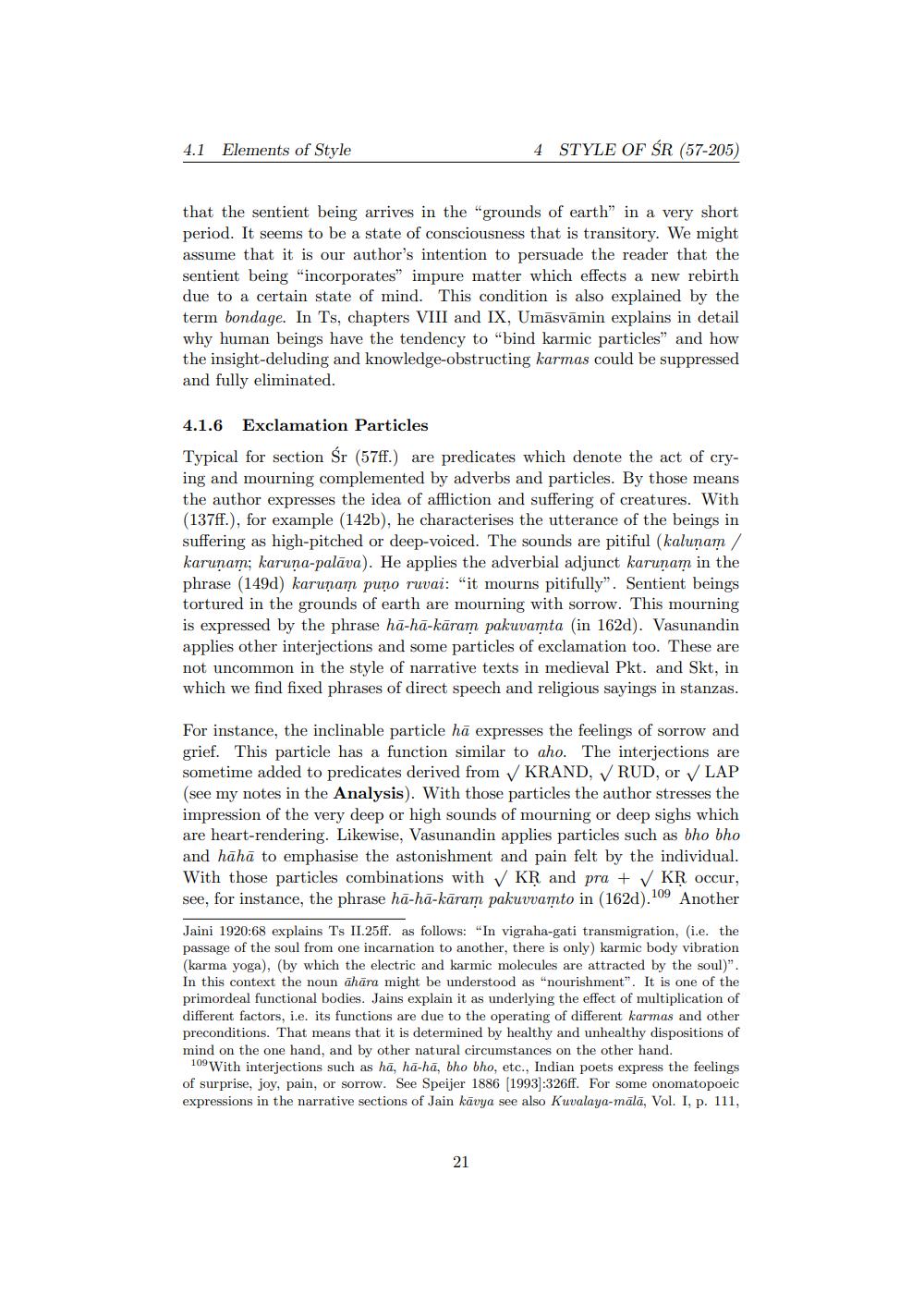________________
4.1 Elements of Style
4 STYLE OF ŚR (57-205)
that the sentient being arrives in the "grounds of earth" in a very short period. It seems to be a state of consciousness that is transitory. We might assume that it is our author's intention to persuade the reader that the sentient being "incorporates” impure matter which effects a new rebirth due to a certain state of mind. This condition is also explained by the term bondage. In Ts, chapters VIII and IX, Umāsvāmin explains in detail why human beings have the tendency to "bind karmic particles" and how the insight-deluding and knowledge-obstructing karmas could be suppressed and fully eliminated.
4.1.6 Exclamation Particles Typical for section Śr (57ff.) are predicates which denote the act of crying and mourning complemented by adverbs and particles. By those means the author expresses the idea of affliction and suffering of creatures. With (137ff.), for example (142b), he characterises the utterance of the beings in suffering as high-pitched or deep-voiced. The sounds are pitiful (kaluņam / karunam; karuņa-palāva). He applies the adverbial adjunct karunam in the phrase (149d) karuņam puno ruvai: "it mourns pitifully". Sentient beings tortured in the grounds of earth are mourning with sorrow. This mourning is expressed by the phrase ha-ha-kāram pakuvamta (in 1620). Vasunandin applies other interjections and some particles of exclamation too. These are not uncommon in the style of narrative texts in medieval Pkt. and Skt, in which we find fixed phrases of direct speech and religious sayings in stanzas.
For instance, the inclinable particle ha expresses the feelings of sorrow and grief. This particle has a function similar to aho. The interjections are sometime added to predicates derived from KRAND, RUD, or LAP (see my notes in the Analysis). With those particles the author stresses the impression of the very deep or high sounds of mourning or deep sighs which are heart-rendering. Likewise, Vasunandin applies particles such as bho bho and hāhā to emphasise the astonishment and pain felt by the individual. With those particles combinations with KR and pra + KR occur, see, for instance, the phrase ha-ha-karam pakuvvamto in (162d).109 Another
Jaini 1920:68 explains Ts II.25ff. as follows: "In vigraha-gati transmigration, i.e. the passage of the soul from one incarnation to another, there is only) karmic body vibration (karma yoga), (by which the electric and karmic molecules are attracted by the soul)". In this context the noun āhāra might be understood as "nourishment". It is one of the primordeal functional bodies. Jains explain it as underlying the effect of multiplication of different factors, i.e. its functions are due to the operating of different karmas and other preconditions. That means that it is determined by healthy and unhealthy dispositions of mind on the one hand, and by other natural circumstances on the other hand.
109 With interjections such as hā, ha-hā, bho bho, etc., Indian poets express the feelings of surprise, joy, pain, or sorrow. See Speijer 1886 (1993):326ff. For some onomatopoeic expressions in the narrative sections of Jain kõvya see also Kuvalaya-mālā, Vol. I, p. 111,
91




